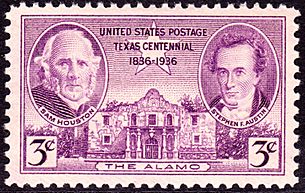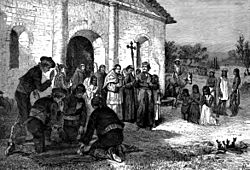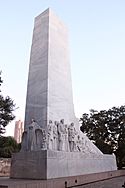Legacy of the Battle of the Alamo facts for kids

The Battle of the Alamo has a huge legacy and impact on American culture. It's a famous event often told from the viewpoint of those who were defeated.
Contents
How People Saw the Alamo
Soon after the battle, people started comparing it to the ancient Greek stand at the Battle of Thermopylae. Both were battles where a small group fought bravely against a much larger army.
Different Views on the Alamo's Meaning
Efforts to save and restore the Alamo have mostly been led by Anglo-Americans (people of English-speaking heritage). This started happening more after 1860, when English-speaking settlers became the majority in Texas.
Many images and stories about the Alamo focus mainly on the Texian defenders. Less attention is given to the Mexican Army or the Tejano soldiers (Texans of Mexican heritage) who fought with the Texians.
Tejanos often saw the Alamo as more than just a battle site. For them, or their ancestors, the Alamo compound had been a mission, a hospital, or a military base. Americans arrived in Texas later, when the Alamo no longer served these roles. So, they tended to see the building only in connection with the famous battle.
In the early 1900s, some people in Texas, especially the white majority, saw the Alamo as a symbol of their power over the Mexican population. This idea came about as a new economic system developed in Texas. In this system, white people were often at the top, earning profits, while Mexican people were often at the bottom, working for wages.
Mexican Views of the Battle
In Mexico, people's views of the battle often matched how they felt about General Antonio López de Santa Anna. At first, news of the Mexican victory praised Santa Anna, especially in newspapers that supported his government. Headlines often said things like, "Immortal Glory to the Illustrious General Santa Anna!"
Within days, people even wrote patriotic songs about Santa Anna's victory at the Alamo. However, Santa Anna's political opponents were not happy that he was getting all the attention. Soon, other newspapers began to question if the victory was worth such a high cost. They also wondered if it would truly help Mexico in the long run.
On April 27, 1836, Mexico's Secretary of War, José María Tornel, announced a special medal for soldiers who fought in Texas. The program was set to start on March 6, 1836, the day of the Alamo battle. But within weeks, the Mexican government learned that Santa Anna had been defeated and captured at the Battle of San Jacinto. Because of this, the medal program was quickly canceled. The Texas campaign, including the Alamo battle, was soon overshadowed by the Mexican–American War in the 1840s.
The Alamo and Later Conflicts
In the 1960s, the Battle of the Alamo was often compared to the Vietnam War. U.S. President Lyndon B. Johnson, whose father helped pass a law to buy the Alamo's long barracks, often made this comparison. In the late 1960s and early 1970s, many anti-war protests were even held at the Alamo grounds.
More recently, a discussion about a book called Forget the Alamo: The Rise and Fall of an American Myth was canceled. The book talks about how the Alamo's story became a "myth" during the Jim Crow era, a time of racial segregation. The cancellation happened because a Republican Lieutenant-Governor, Dan Patrick, said the book was "fact-free rewriting of TX history." This event highlights ongoing debates about how history, especially about topics like critical race theory, is taught and understood in Texas.
The Alamo Mission Today
After the Mexican victory at the Battle of the Alamo, Mexican troops stayed in the Alamo Mission. When the Mexican army left Texas after the Battle of San Jacinto, they tore down many walls and burned the wooden fence that Davy Crockett had defended.
Over the next few decades, other buildings in the complex were taken down. In 1850, the United States Army added a triangular roof section, called a gable, to the top of the chapel. Some people think this gable originally came from Mission San José.
Today, the Alamo's remains are in Downtown San Antonio, Texas. The church building is still standing and is an official state shrine to the Texian defenders. In the early 1900s, many Texans wanted to tear down the remaining building, the Long Barrack. But Clara Driscoll, a wealthy rancher's daughter, bought the building to make it a museum.
Later, the Texas Legislature bought the property and made the Daughters of the Republic of Texas its permanent caretakers. In front of the church, in the middle of Downtown San Antonio's Alamo Plaza, there is a cenotaph. This monument was designed by Pompeo Coppini and built in 1939. It honors the Texians who died during the battle. According to one author, the Alamo has become "the most popular tourist site in Texas."
The Alamo in Books

Many Mexican officers who fought in the battle wrote down their memories, some many years later. These included Antonio López de Santa Anna and Vicente Filisola. Texians Juan Seguín and John Sutherland also wrote memoirs. However, some historians believe Sutherland wasn't actually at the Alamo and wrote his story based on what he heard.
Among the Texian survivors, the account of Susanna Dickinson was given the most importance. She was the only American adult to survive. Other survivors, like former slaves and several Tejanos, were not as widely recognized.
The first list of Texian victims was published on March 24, 1836, in the Telegraph and Texas Register newspaper. It had 115 names. In 1843, John Henry Brown, a former Texas Ranger and historian, wrote the first history of the battle. It was a pamphlet called The Fall of the Alamo.
Another important work was Reuben Potter's The Fall of the Alamo, published in 1860. Potter based his work on interviews with many Alamo survivors. One of the most used sources about the Alamo is Amelia W. Williams's doctoral paper, "Critical Study of the Siege of the Alamo and of the Personnel of Its Defenders." Finished in 1931, it tried to identify all the Texians who died. Her list was used for the names carved into the cenotaph memorial in 1936.
Some historians believe her list included men who did not die at the Alamo. Still, Williams gathered a lot of information, and her work is a starting point for many historians. The first full-length book about the battle was published in 1948, called The Alamo by John Myers Myers. Many books have followed, including Walter Lord's famous work in 1961, A Time to Stand.
As the 1800s went on, the battle started appearing in many novels and plays. In 1869, Jeremiah Clemens and Bernard Lile wrote fictional stories about the battle. Novelist Amelia Barr wrote her own fictional version, Remember the Alamo, in 1888. In these early novels, the Alamo parts were often small, perhaps added to make the books more interesting and sell better.
The Alamo in Art
The first artistic picture of the battle appeared in 1838 in John Milton Niles's History of South America and Mexico. These early paintings often showed buildings that didn't look like the Alamo at all. They also showed battles that happened very differently from the real 1836 battle. However, their existence and popularity made the Alamo more famous. They likely helped bring the first tourists to the battle site.
The Alamo in Movies
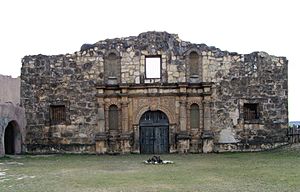
Many Americans have learned about the Alamo from movies, not just books. The first film about the battle, The Immortal Alamo, came out in 1911 but is now lost. Over the next 40 years, other movies focused on figures like Davy Crockett.
The Alamo became very popular on TV in 1955 with Walt Disney's Davy Crockett: King of the Wild Frontier. This show was mostly based on myths. In the early 1950s, John Wayne started planning a film about the Alamo. He starred as Davy Crockett in his 1960 movie The Alamo.
Even though the screenwriter claimed to have done a lot of research, historians say there isn't a single scene in The Alamo that matches a real historical event. The movie was even banned in Mexico. The movie set, called Alamo Village, includes a copy of the Alamo Mission and a Mexican city. It is still used today for filming movies.
As the 150th anniversary of the battle neared in the 1980s, more movies were made. These included the TV movie The Alamo: 13 Days to Glory, which some say is the most historically accurate Alamo film. Another film, Alamo... The Price of Freedom, was also made in the 1980s. It was filmed in IMAX format with historical re-enactors instead of professional actors. It's shown only in San Antonio, near the Alamo. It's only 45 minutes long but is known for its amazing detail and intensity.
In 2004, another film, also called The Alamo, was released. It starred Billy Bob Thornton as Crockett and Dennis Quaid as Sam Houston. However, this movie was one of the biggest box office failures that year. In the movie Pee-wee's Big Adventure, Pee-wee Herman is told his stolen bike is in the Alamo's basement. But a tour guide later tells him the Alamo has no basement!
The Alamo in Music
Many songwriters have also been inspired by the Battle of the Alamo. For example:
- "Remember the Alamo" (1955), written by Jane Bowers, was recorded by the Kingston Trio, Johnny Cash, and others.
- Tennessee Ernie Ford's song "The Ballad of Davy Crockett" (1955) was very popular, reaching number 4 on the country music charts.
- In 1960, Marty Robbins recorded "The Ballad of the Alamo," which reached number 34.
- The English band Babe Ruth's song "The Mexican" (1972) tells the story from the Mexican point of view.
Alamo Replicas
Copies of the Alamo have been built in different places. One is a large home in Spicewood, near Austin. Built in 2007, it looks rustic on the outside but is much more luxurious inside than the real Alamo.
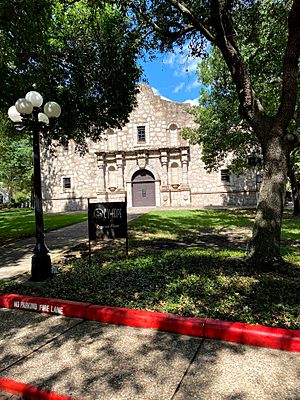
Another replica is located on the grounds of the Cy-Hope foundation in Cypress. This copy was built by 'Bud' Hadfield, the founder of Kwik Kopy. The complex is used as a wedding reception and banquet hall. In mid-2020, visits to the Cypress Alamo decreased because of the COVID-19 pandemic.


